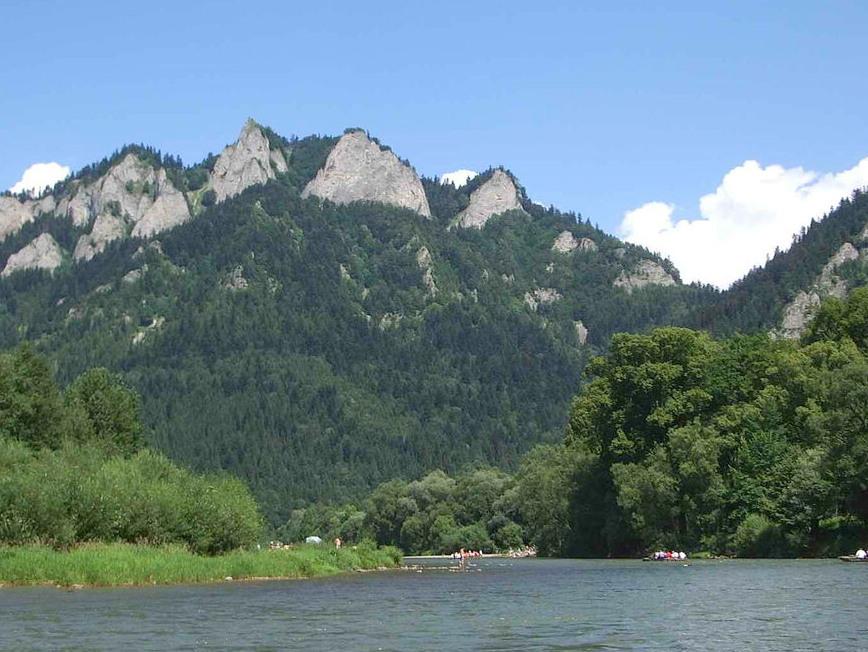- Pieniny National Park (Poland)
Infobox_protected_area | name = Pieniny National Park
native_name=Pieniński Park Narodowy
iucn_category = II

caption =
locator_x =
locator_y =
location =Lesser Poland Voivodeship ,Poland
nearest_city =
lat_degrees =
lat_minutes =
lat_seconds =
lat_direction =
long_degrees =
long_minutes =
long_seconds =
long_direction =
area = 23.46 km²
established = 1932
visitation_num =
visitation_year =
governing_body = Ministry of the EnvironmentPieniny National Park ( _pl. Pieniński Park Narodowy) is a protected area in
Lesser Poland Voivodeship , southernPoland , in the heart of the Pieniny Mountains.Pieniny National Park is one of the smallest
Polish National Parks , lying in the southernmost part of the country, on the border withSlovakia . ThePieniny mountain range is divided into three parts -Pieniny Spiskie ,Małe Pieniny , andPieniny Właściwe (where the park is located). The Park’s area is convert|23.46|km2|sqmi, of which 13.11 km² is forested. One-third (7.5 km²) is strictly protected.The Park has its headquarters in the village of
Krościenko nad Dunajcem . There is also a National Park on the Slovakian side of the mountains, called "Pieninský národný park ".History
The idea for the creation of the National Park came in 1921 from Professor Władysław Szafer from the National Commission for the Preservation of Nature ("Państwowa Komisja Ochrony Przyrody"). In the same year a private preserve on the area of 75,000 m² was opened by S. Drohojowski around the ruins of the
Czorsztyn castle. In 1928 Polish government made first land purchases and on May 23, 1932 the Ministry of Agriculture created a “National Park in the Pieniny”, on the area of 7.36 km². After theWorld War II , the decision was confirmed by the Oct 30, 1954 bill, which officially created Pieniny National Park.Features
The Pieniny mountains are mainly built from limestone and they create picturesque and impressive, almost perpendicular walls which go down towards the
Dunajec River . The most famous peak -Trzy Korony (Three Crowns) is 982 meters above sea level high, however Pieniny’s highest peak - Wysoka - is 1050 meters above sea level and is not located on Park’s area.Pieniny National Park is located in the Dunajec river basin, and the river occupies important position among factors that influence Pieniny’s look. Even though the Park is small in size, on its area thrive hundreds of species of plants, including 640 kinds of mushrooms. Sometimes, on the same rock, grow plants with opposite means of survival. Park’s meadows, which are the result of human activity, are some of the richest plant ecosystems of Poland (30 to 40 species of flowers for every square meter).
So far around 6500 animal species have been proven to live in the
Pieniny . It is supposed that the area is even more abundant - with up to 15 000 species. There are numerous birds, fish, reptiles and amphibians as well as mammals. The most important predator is the lynx. On the shores of the Dunajec the otter thrives.First permanent human settlements in the Pieniny mountains date back to 1257, when Polish princess Kinga was given nearby lands. In 1280 the princess founded a monastery at
Stary Sącz , later the Czorsztyn castle was built. This castle belonged to Poland, on the southern side of theDunajec valley , the Hungarians built their own, then called Dunajec (today it belongs to Poland and its name isNiedzica ). The Dunajec valley in 1997 was flooded by water, as a result of construction of a river dam.There are 34 kilometres of tourist walking trails in the park, from such peaks as
Sokolica andTrzy Korony one can have excellent view on the Pieniny and theTatra mountains as well as theDunajec . The Park’s main attraction is a river trip on wooden boats, very popular among all tourists.See also
*
Dunajec River Gorge External links
* [http://www.pieninypn.pl/ Park's official website]
* [http://www.mos.gov.pl/kzpn/en/pien_gb.htm The Board of Polish National Parks]
* [http://www.pieninyportal.com/index.php/en/national-park-pieniny.page Pieniny National Park portal page]
Wikimedia Foundation. 2010.
